
1. Sakai Station Tourist Information Center
Start!

Sakai has a dazzling history, functioning as the largest trading city in Japan 500 years ago and then going on to develop into a major commercial center.
The stage for all of this was the Old Town Area, spreading to the north and south of the line along which the so-called "Chin Chin Densha" currently runs. Even after being ravaged by the fires of war, a variety of buildings still remain today that tell of that period in Sakai's history. A range of traditional culture has also been passed down since that time, including everything from construction and traditional crafts to cuisine.
One of the best ways to discover the appeal of this area for yourself is to take a tour on a rented bicycle. Starting from the Kishu Road, Sakai offers wide and relaxed roadways that are perfect for cycling.
{{ // BLOCK END }}

1. Sakai Station Tourist Information Center
Start!
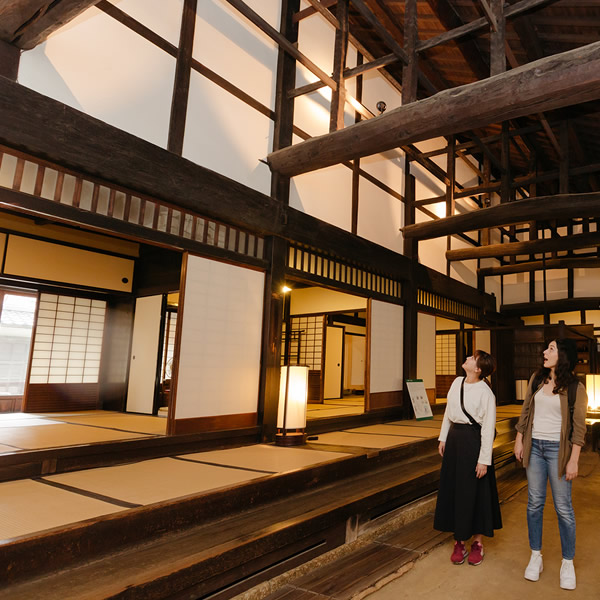
2. Sakai Municipal Machiya Historical Museum Yamaguchi Residence
Sakai Station Tourist Information Center
->Sakai Municipal Machiya Historical Museum Yamaguchi Residence
Approximately 1.8km, 10 minute

3. Shichido Area
Sakai Municipal Machiya Historical Museum Yamaguchi Residence
->Shichido Area
Approximately 0.5km, 3 minutes
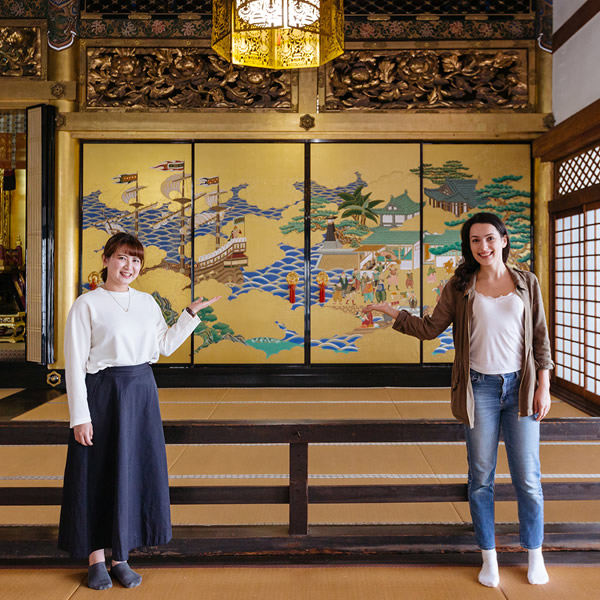
4. Honganji Sakai Betusuin
Shichido Area->Honganji Sakai Betusuin
Approximately 1.1km, 7 minutes
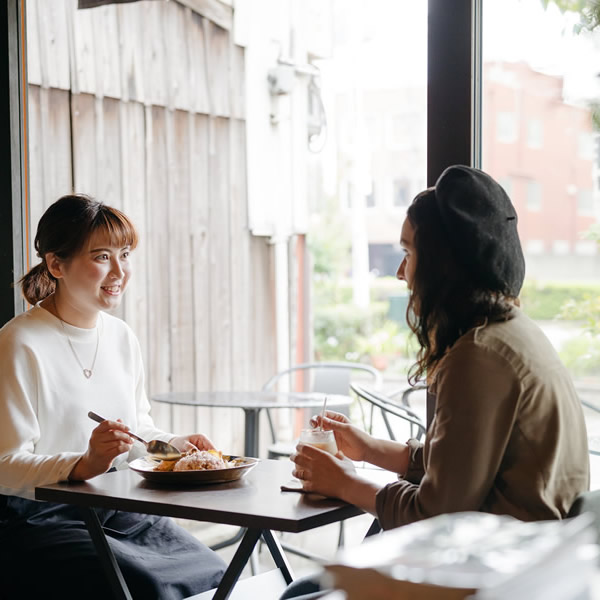
5. SAKAINOMA cafe
Honganji Sakai Betusuin
->SAKAINOMA cafe
Approximately 1.1km, 7 minutes
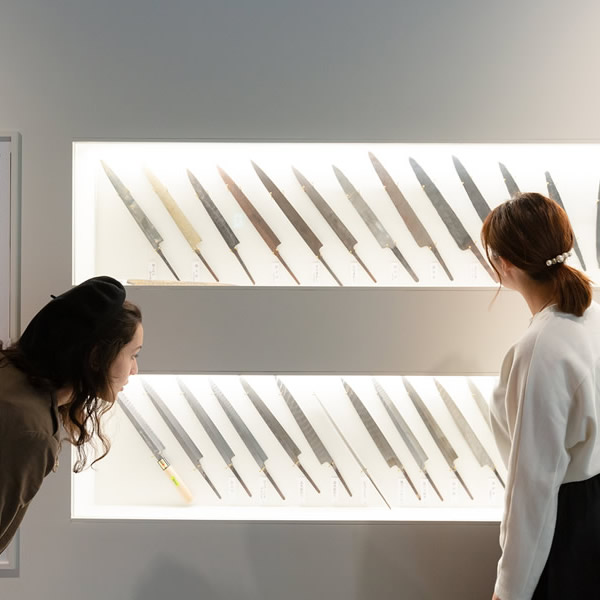
6. Sakai-Tohji Knife Museum
SAKAINOMA cafe
->Sakai-Tohji Knife Museum
Approximately 1km, 5 minutes
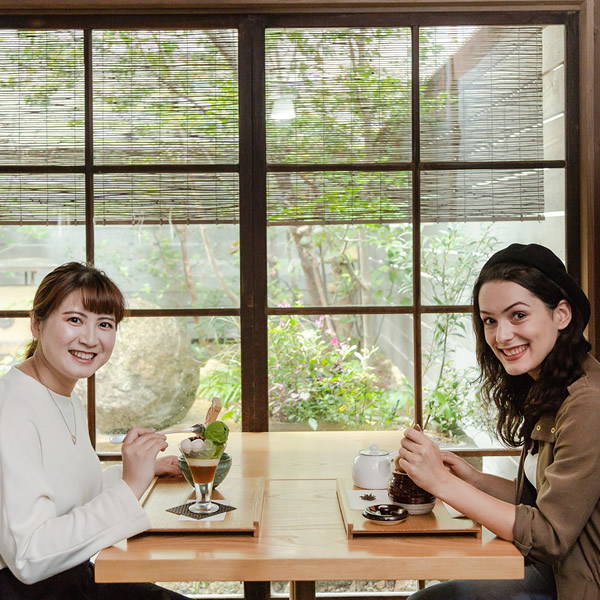
7. Saryo Tsuboichi Seicha Main Store
Sakai-Tohji Knife Museum
->Saryo Tsuboichi Seicha Main Store
Approximately 0.1km, 1 minute

8. Sakai Traditional Crafts Museum
Saryo Tsuboichi Seicha Main Store
->Sakai City Traditional Crafts Museum
Approximately 0.5km, 3 minutes

9. Sakai Station Tourist Information Center
Sakai City Traditional Crafts Museum->Sakai Station Tourist Information Center
Approximately 1.1km, 7 minutes
Goal!
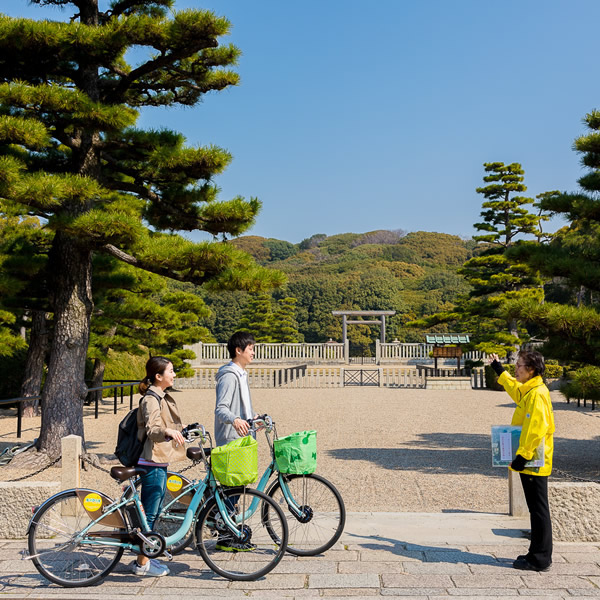
~ Stretch your legs and head to the Mozu Tumuli Cluster ~
After taking a tour of the Sakai Old Town, it is also recommended to stretch your legs by visiting the Mozu Tumuli Cluster.
If you are using an electric assisted bicycle then you can reach the prayer place at the Nintoku-Tenno-Ryo Tumulus, the latest keyhole-shaped tumulus in Japan, in around 20 minutes from Sakai Station.
{{ // BLOCK END }}
Start by renting your bicycle from the Sakai Station Tourist Information Office, which is connected directly to the west exit of Nankai Sakai Station. Not only is the rental process exceedingly simple, but you will also find all sorts of useful sightseeing information here, including maps and pamphlets. There are volunteer staff permanently posted here who know all about the culture and the city of Sakai, and can provide the best places to see at each time of year and details on sightseeing routes.
Renal bicycles for 1 day: regular bicycle 300 yen, electric assist bicycle 500 yen
Reception times: 9:00 - 16:30
Use requires presentation of identification, such as a driver's license or passport.
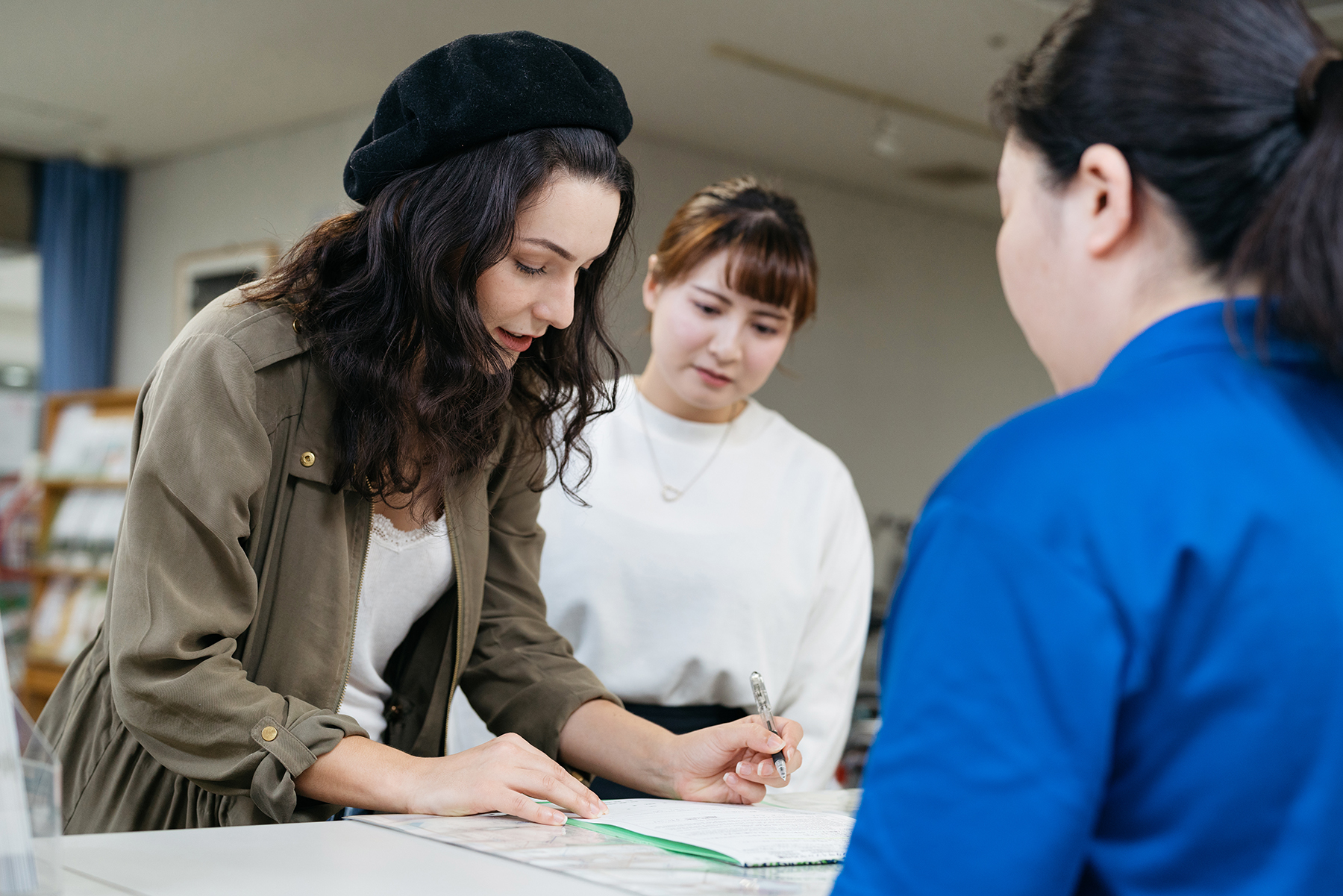
{{ // BLOCK END }}
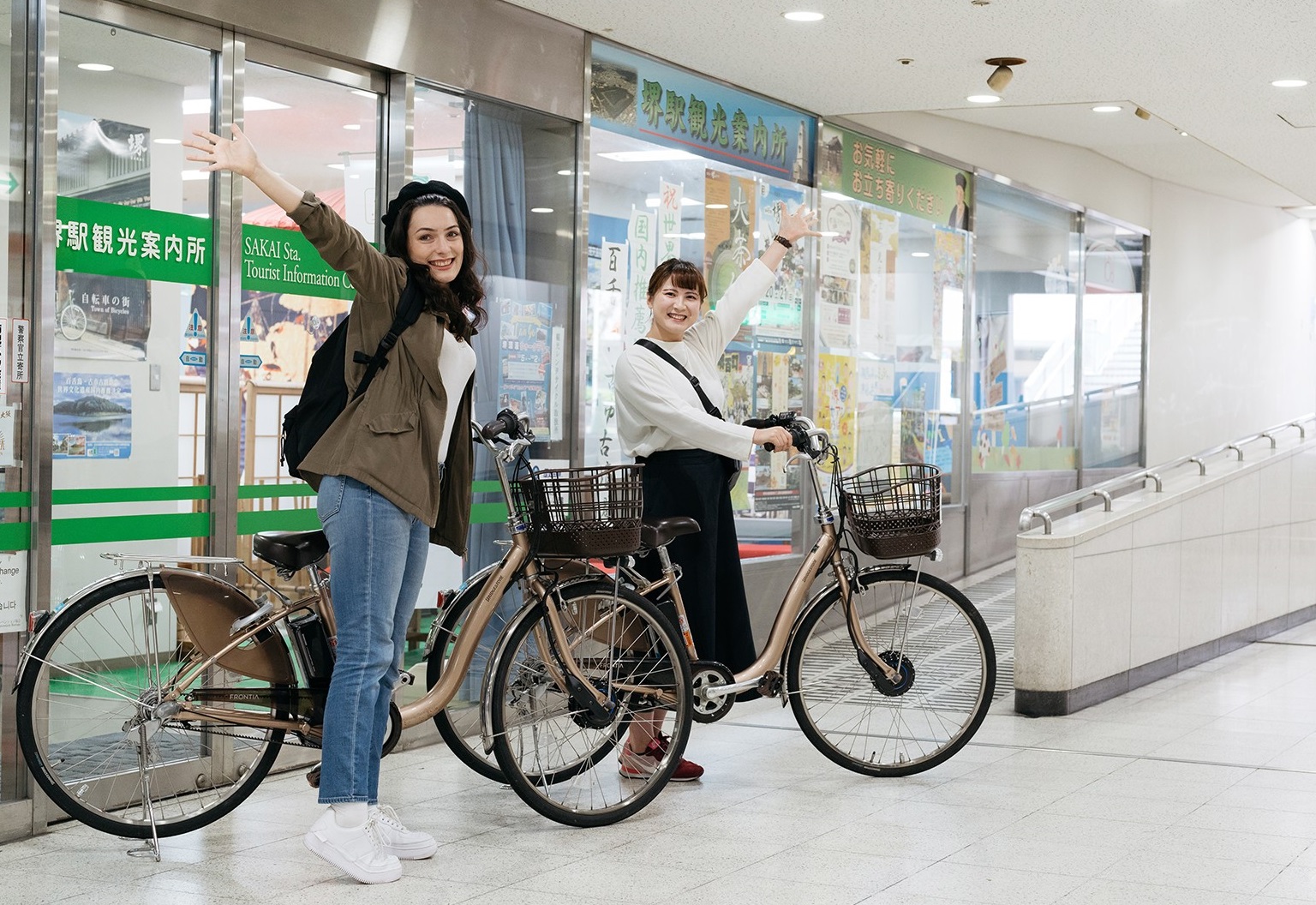
{{ // BLOCK END }}
Required Time: Approximately 1.8km, 10 minute ->
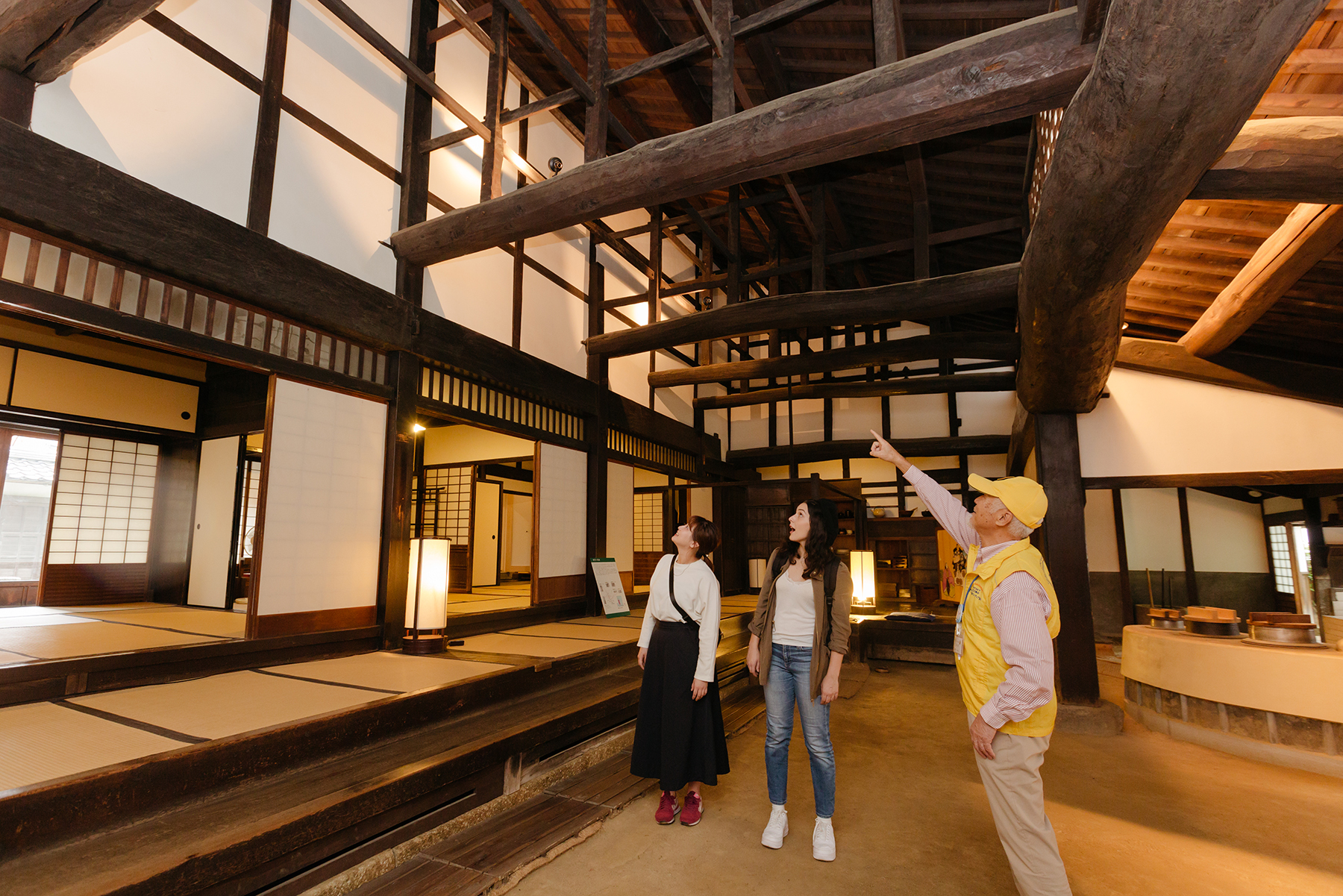
{{ // BLOCK END }}
A fantastic wooden construction, and one of the best sights of the Old Town. In the past, when Sakai flourished for trade and commerce, the people always spent a lot of money on their homes. The Sakai Municipal Machiya Historical Museum Yamaguchi Residence is the ultimate example of this, with grounds that cover 840㎡. It is a rare example of Machiya construction from the start of the 17th century, and is a nationally designated Important Cultural Asset. "Machiya" itself refers to a style of building in which a commercial space, such as a shop, and a residential space are combined together, and they are also characterized by a wide entryway. The ceilings with their thick rafters in a lattice pattern have to be seen to be believed! Deeper inside the building, you'll find a living room facing out onto a beautiful garden.
{{ // BLOCK END }}

The old kitchen. The five cooking ranges speak to how many servants there must have been here in the heyday of the house.
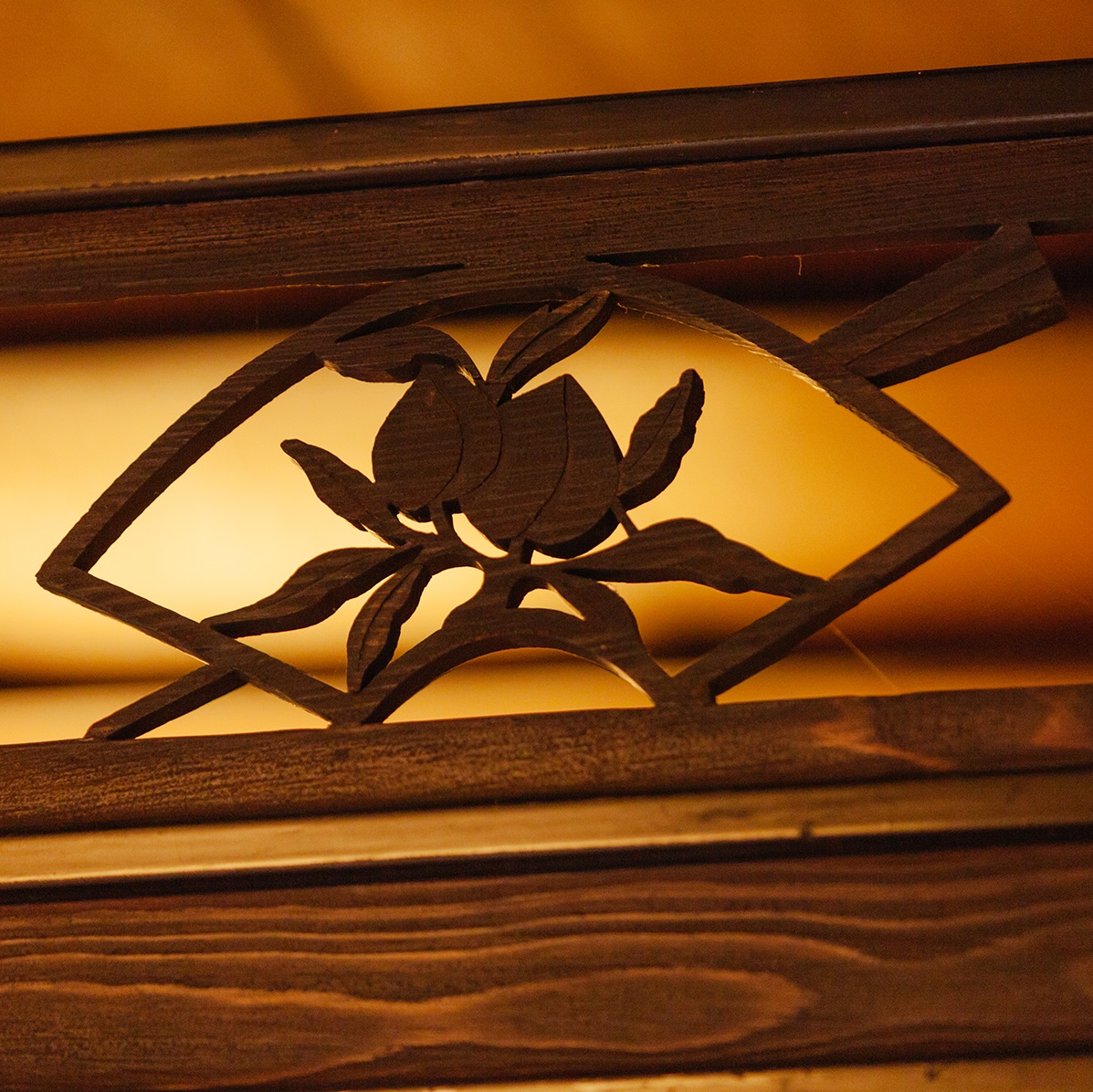
The living room is decorated with details called "Ranman," openwork screens above the sliding doors that let additional light and air into the room.
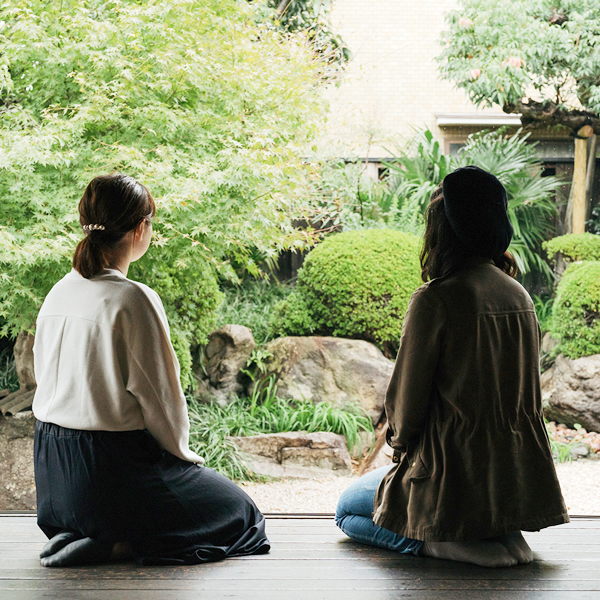
The garden that the rear room faces onto is also worth seeing. Sitting on the tatami mats or veranda provides a moment of well-spent relaxation.
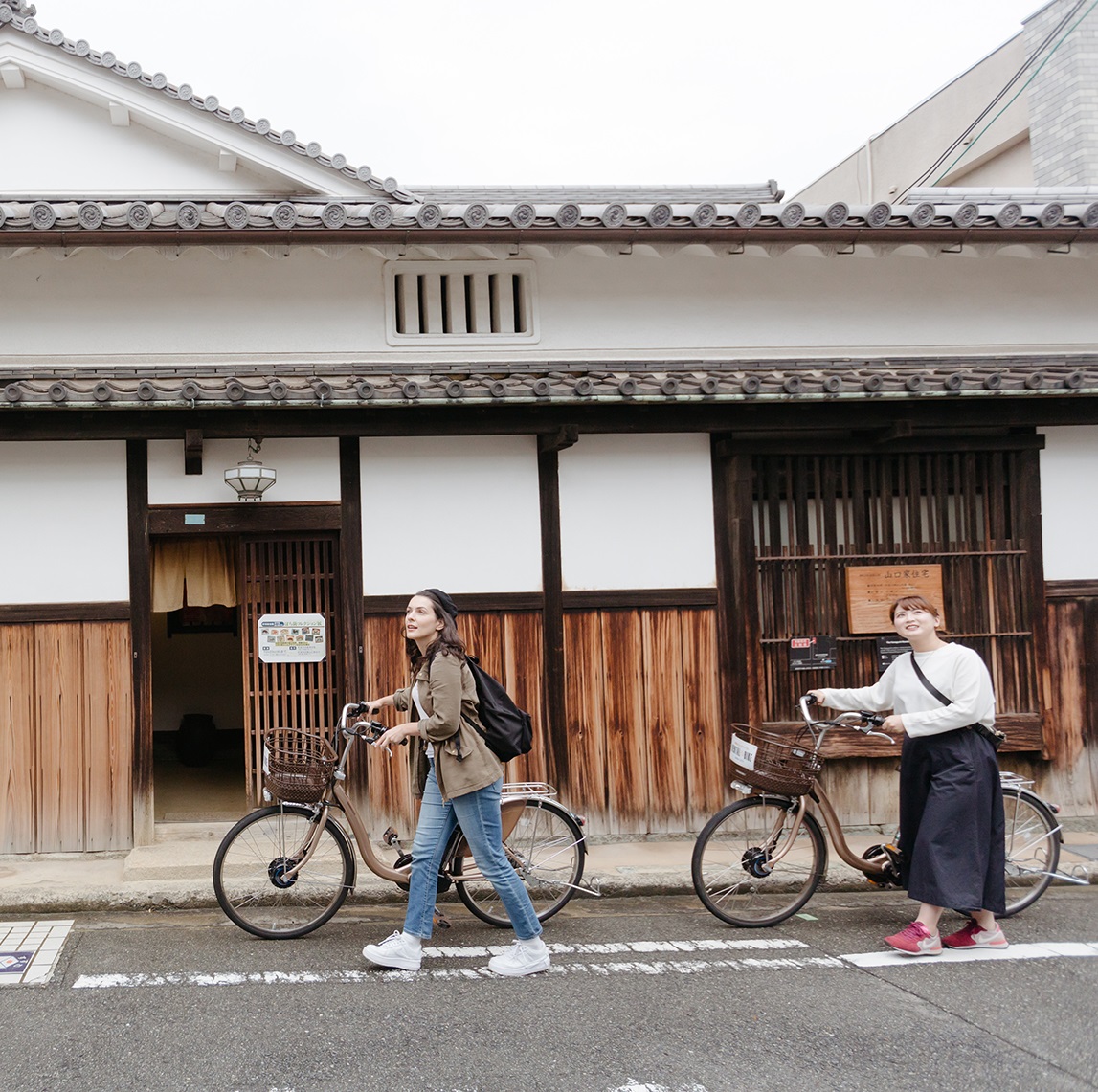
The exterior is also a beautiful sight worth appreciating, with white stucco, wood sliding walls, and overlapping titled roofs. "Tasteful" barely scratches the surface!
{{ // BLOCK END }}
Required Time: Approximately 0.5km, 3 minutes ->
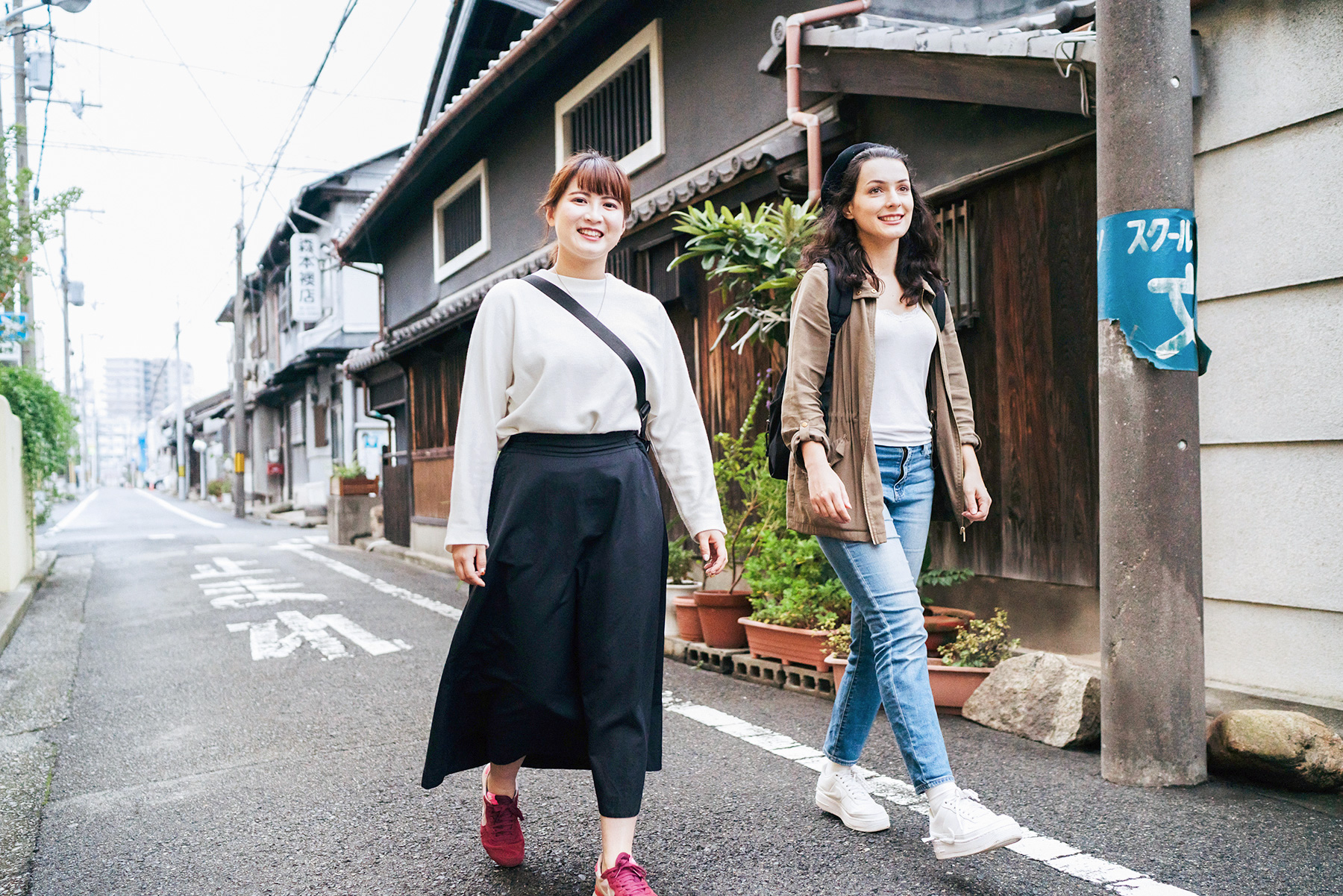
{{ // BLOCK END }}
Head a little north from the Yamaguchi Residence to reach the Shichido area, where many historical Machiya buildings still remain. Due to all the gunsmiths who lived here during more recent times, it is also still known as "Gun Town," and a Gunsmith's Home from that period still stands here. The neighborhood includes long standing senko incense stores, knife stores, thrift stores that only open on the weekends, and interior stores, allowing you to encounter a multitude of hints about both new and old lifestyles in the area. It is recommended to stop your bicycle nearby and talk a leisurely stroll.
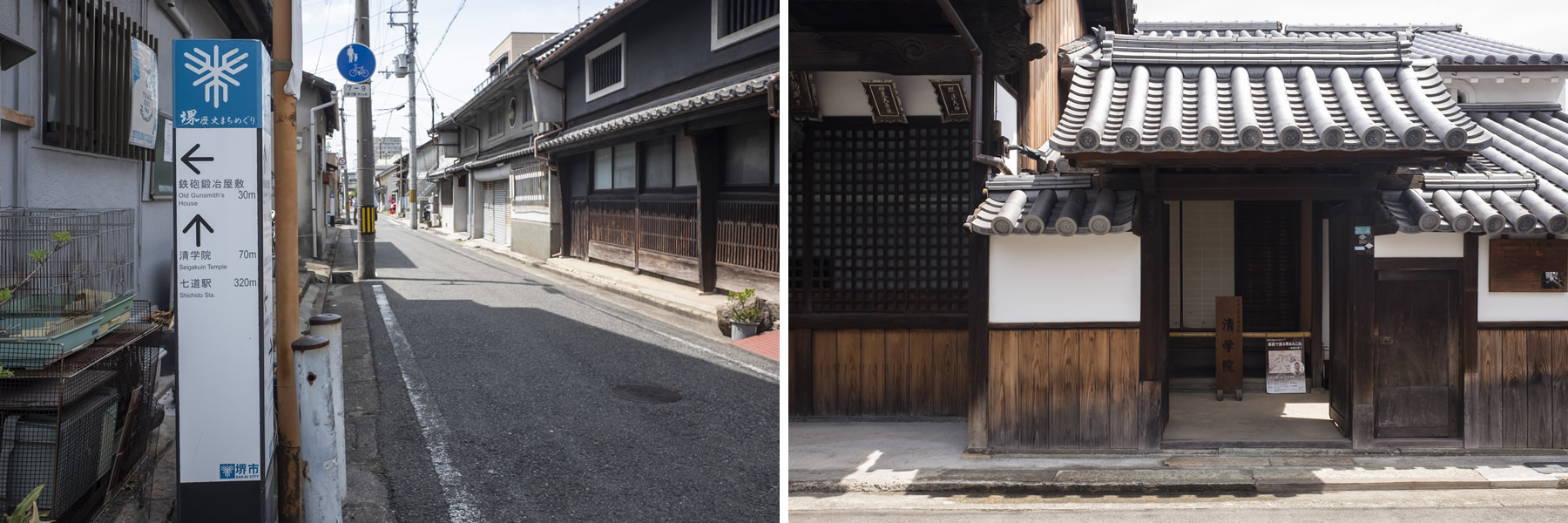
{{ // BLOCK END }}
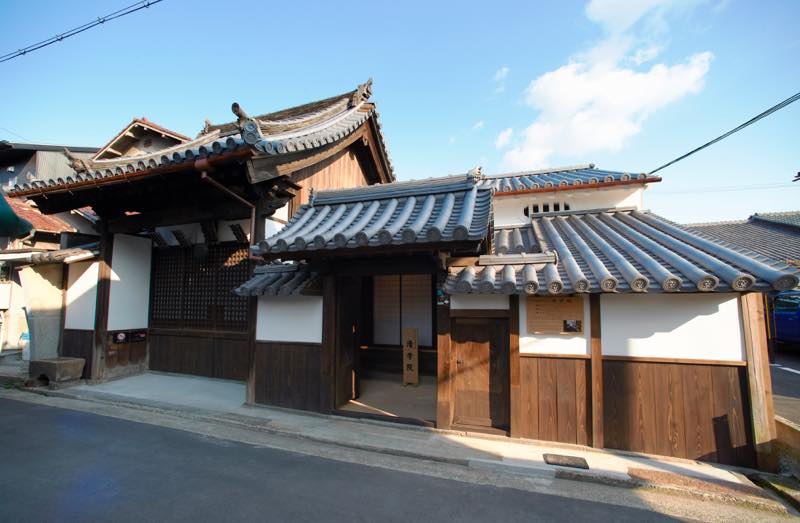
Sakai Municipal Machiya Historical Museum Seigakuin

Gunsmith's Home
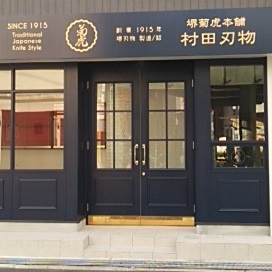
Sakai Kikutora Honpo Murata Hamono
{{ // BLOCK END }}
Required Time: Approximately 1.1km, 7 minutes ->
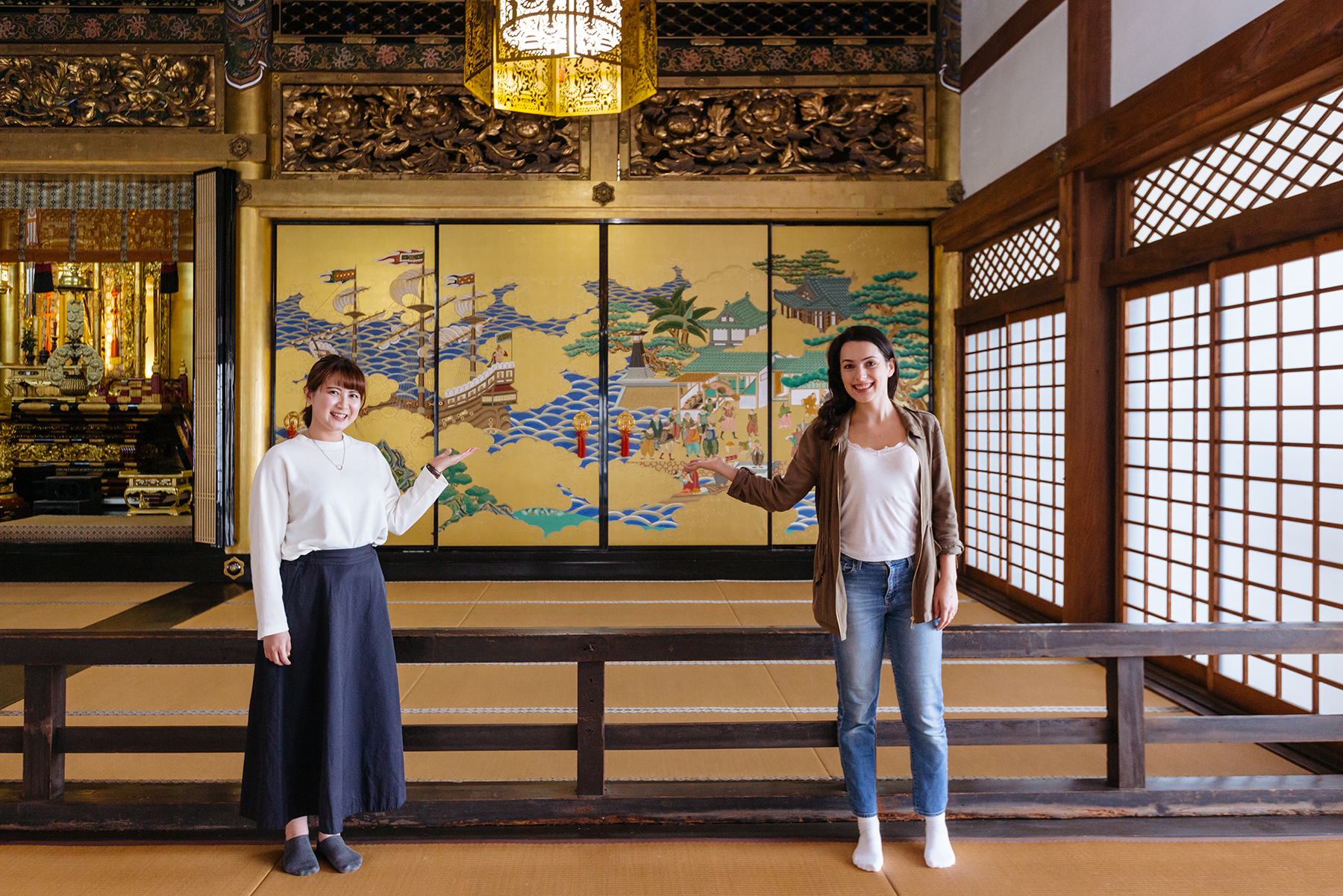
{{ // BLOCK END }}
The next stop is a temple of the Shinshu Honganjiha branch of Buddhism, founded in the 14th century. The main temple was rebuilt in 1825, and is famous as the largest wooden structure in Sakai. The bold interior features gold leaf and richly colored carvings, like a depiction of paradise itself. The sliding screens on the left and right depict trading with foreigners in Sakai during the middle ages, giving a clear picture of how the city flourished. As modernization proceeded, Sakai actually became a Prefecture for a brief period, and for the 10 years from 1871 this temple was also used as the Sakai Prefectural Office.
*The grounds can be viewed freely. If you wish to see the main temple, a prior reservation is required.
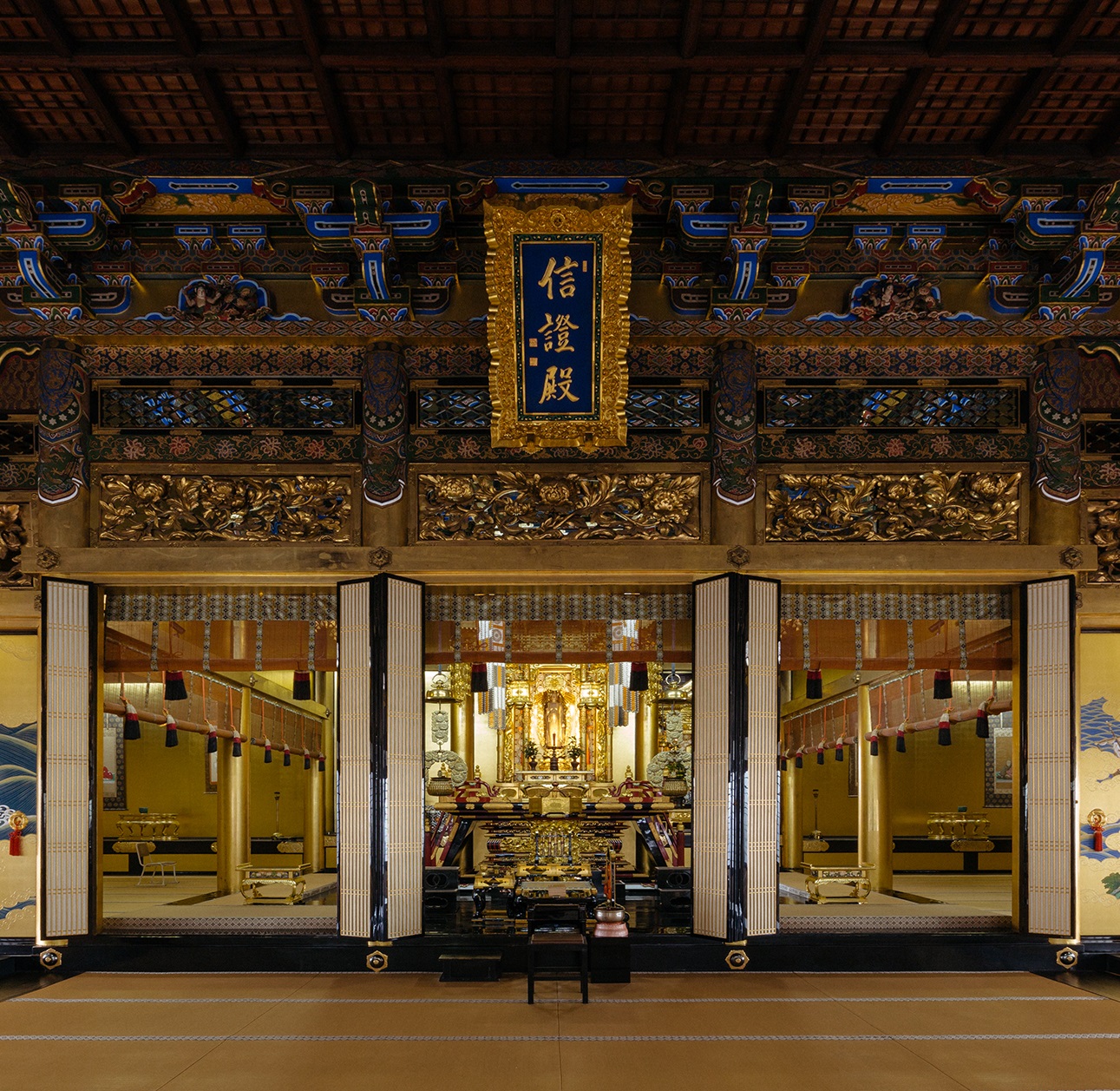
The interior decorations enshrining the principle object of worship here are especially impressive. Through the work of skilled craftspeople they are decorated with gold leaf and brilliant colors.
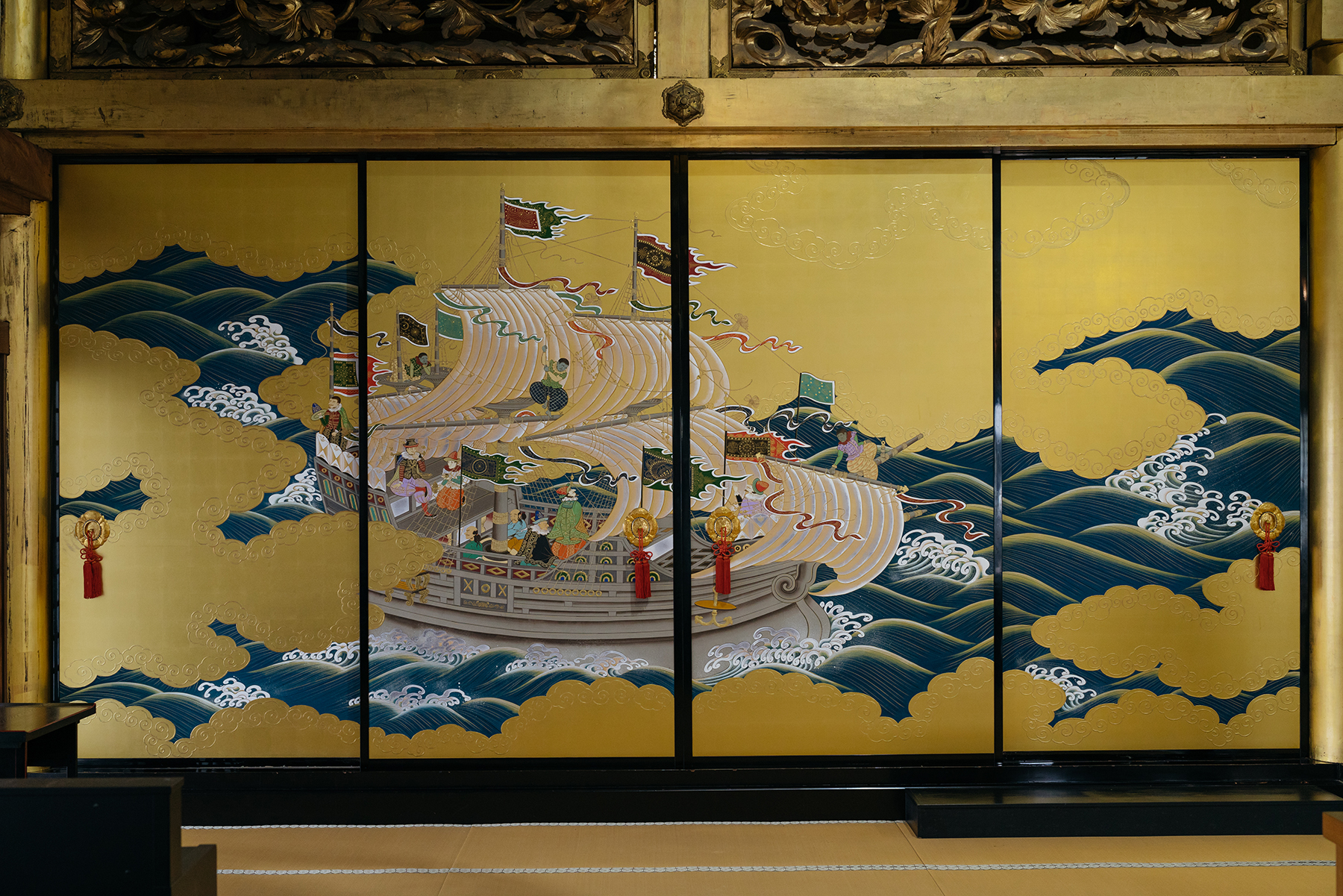
The splendid sliding screens were newly made in 1999 to commemorate the 500th memorial service for the passing of Rennyo, the restorer of the sect.
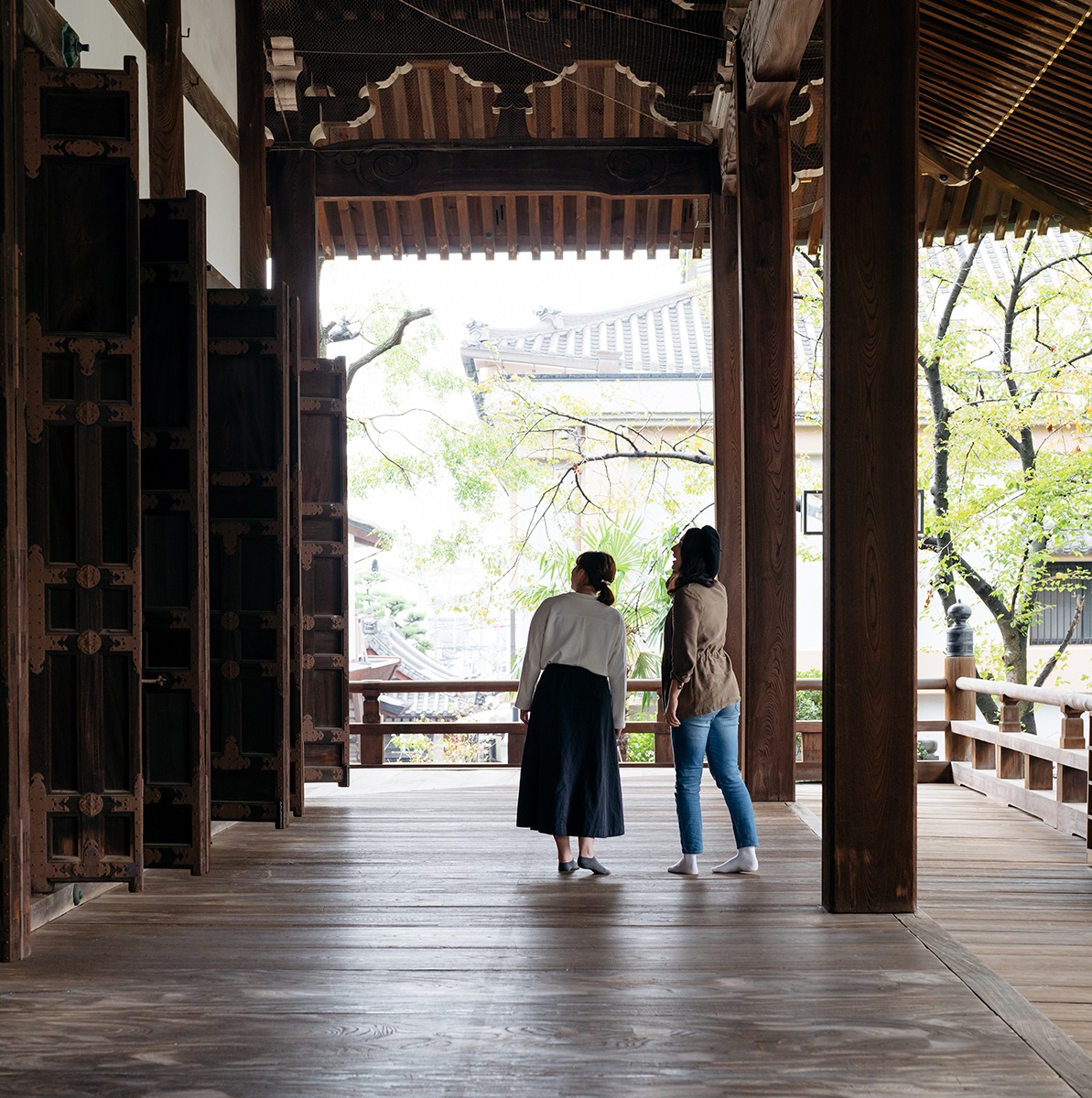
The corridors in the main temple, which was rebuilt in 1825, are wide and spacious. There is also plenty to see with all the detailed carvings.

A statue of Rennyo standing in the grounds. Big enough that you'll have to look upward, it also faces a statue of the founder of the sect, Shinran.
{{ // BLOCK END }}
Required Time: Approximately 1.1km, 7 minutes ->
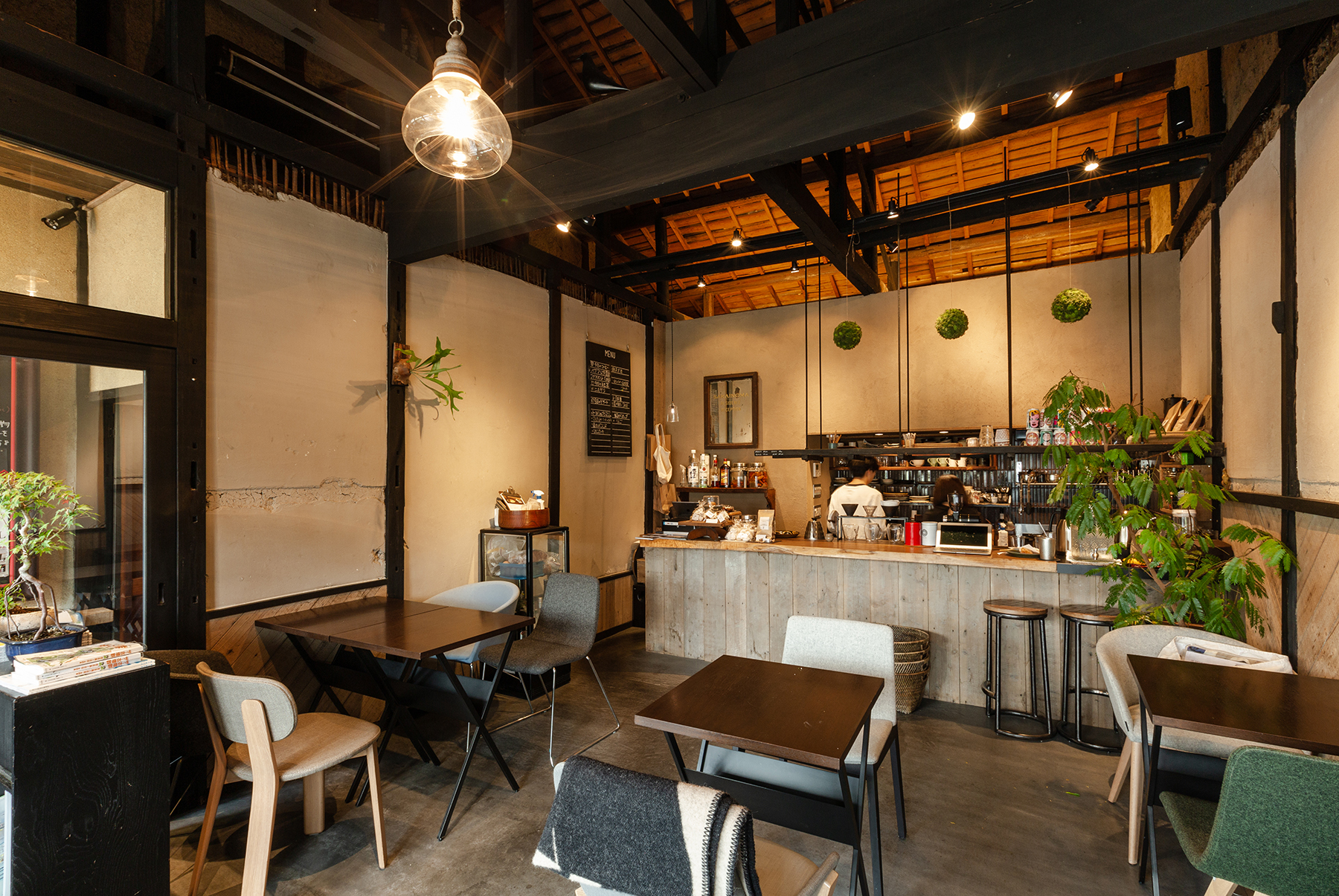
{{ // BLOCK END }}
An old private house that has stood for 60 years, now renovated into a cafe and lodging facility, it makes the perfect spot for lunch or to take an afternoon break.
The menu includes everything from meals, such as handmade bagel sandwiches using locally produced ingredients and chicken curry, to sweets featuring seasonal fruit and drinks.
As both locals and travelers gather here, it is also the perfect place for collecting information, and the blackboard in the corridor is always packed with the details of recommended spots and the latest hot news. The staff also all love Sakai, so be sure to ask for any tips they have on tucked-away spots that only locals are likely to know about.
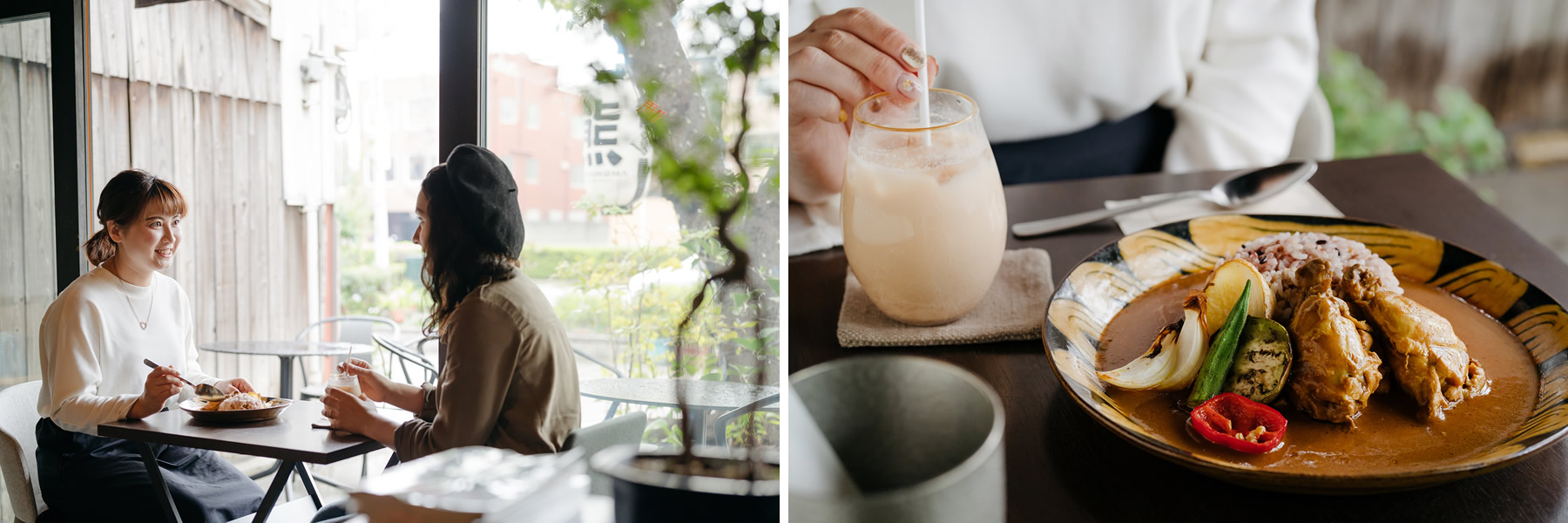
{{ // BLOCK END }}
Required Time: Approximately 1km, 5 minutes ->
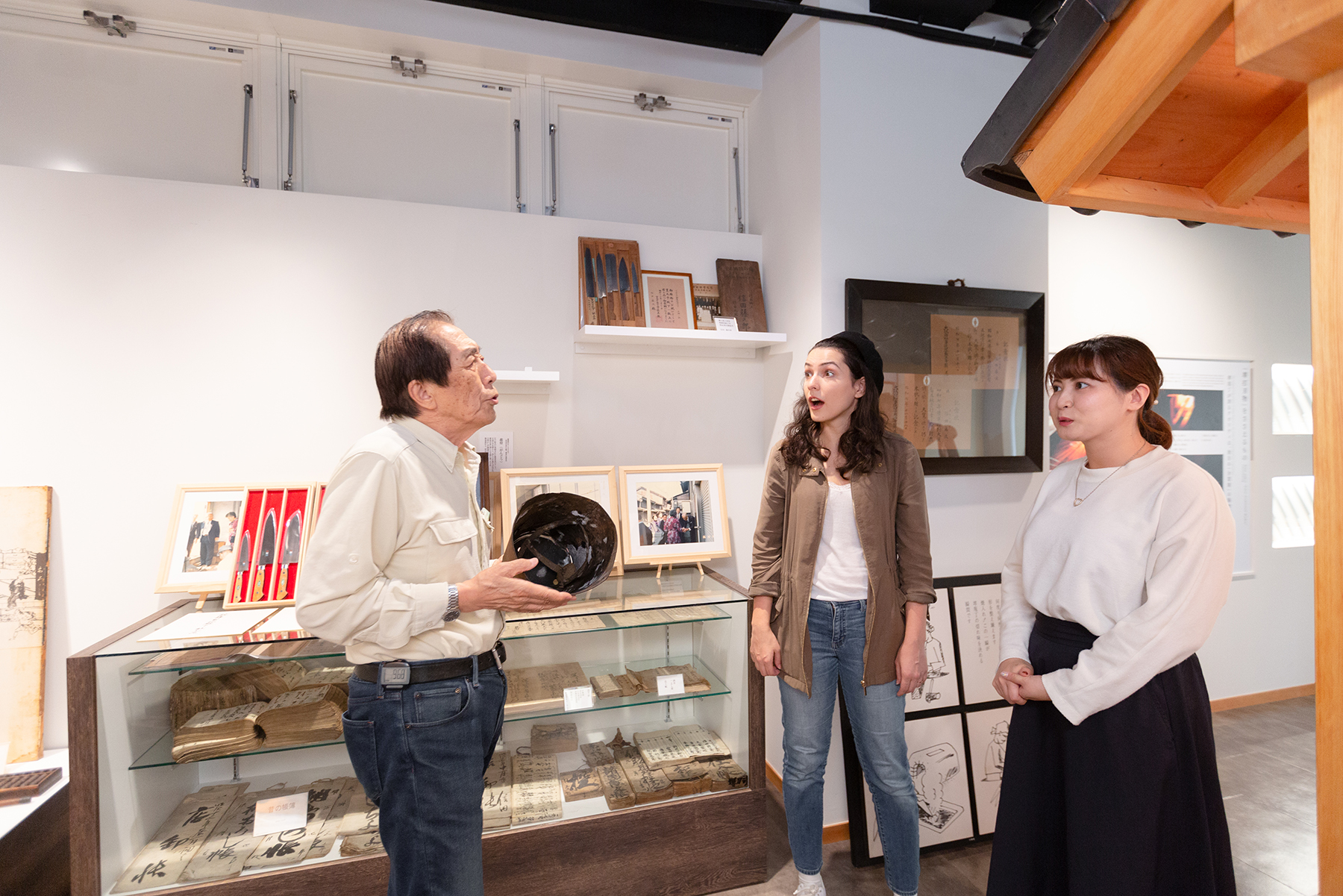
{{ // BLOCK END }}
Making knives and blades is one of the traditional industries of Sakai, boasting an estimated history of around 600 years. The quality created by the skills of veteran craftspeople is the highest level found anywhere in Japan, and boasts a 98% share of the market of knives used by professional Japanese chefs. This museum allows you to learn in detail about the history and production methods of these Sakai knives, while taking in a rich selection of exhibited materials. It is operated by the long-standing knife store known as Sakai-Tohji, which was founded in 1805. Another appealing point is that knife craftspeople themselves will guide you, providing both rich detail and ease of understanding. You also can't miss the exhibit of the bayonets and matchlocks that formed the basis of the technology for cooking knife production. There is also a shop located next to the museum, where you can actually purchase professional knives.
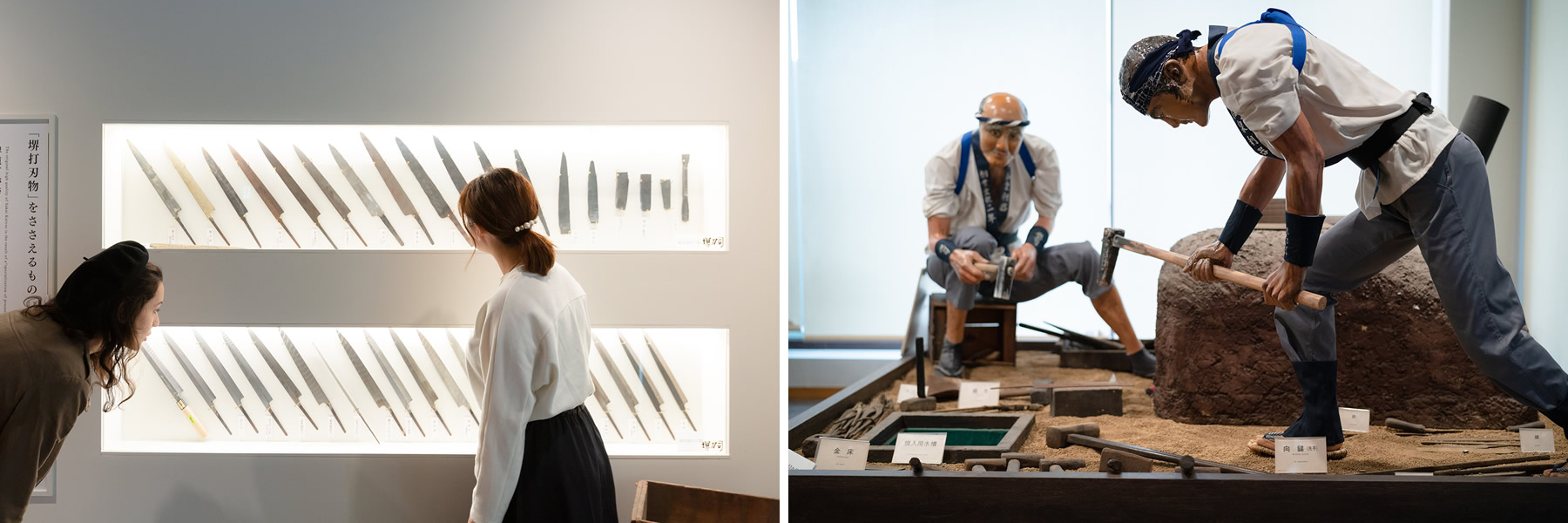
{{ // BLOCK END }}
Required Time: Approximately 0.1km, 1 minute ->
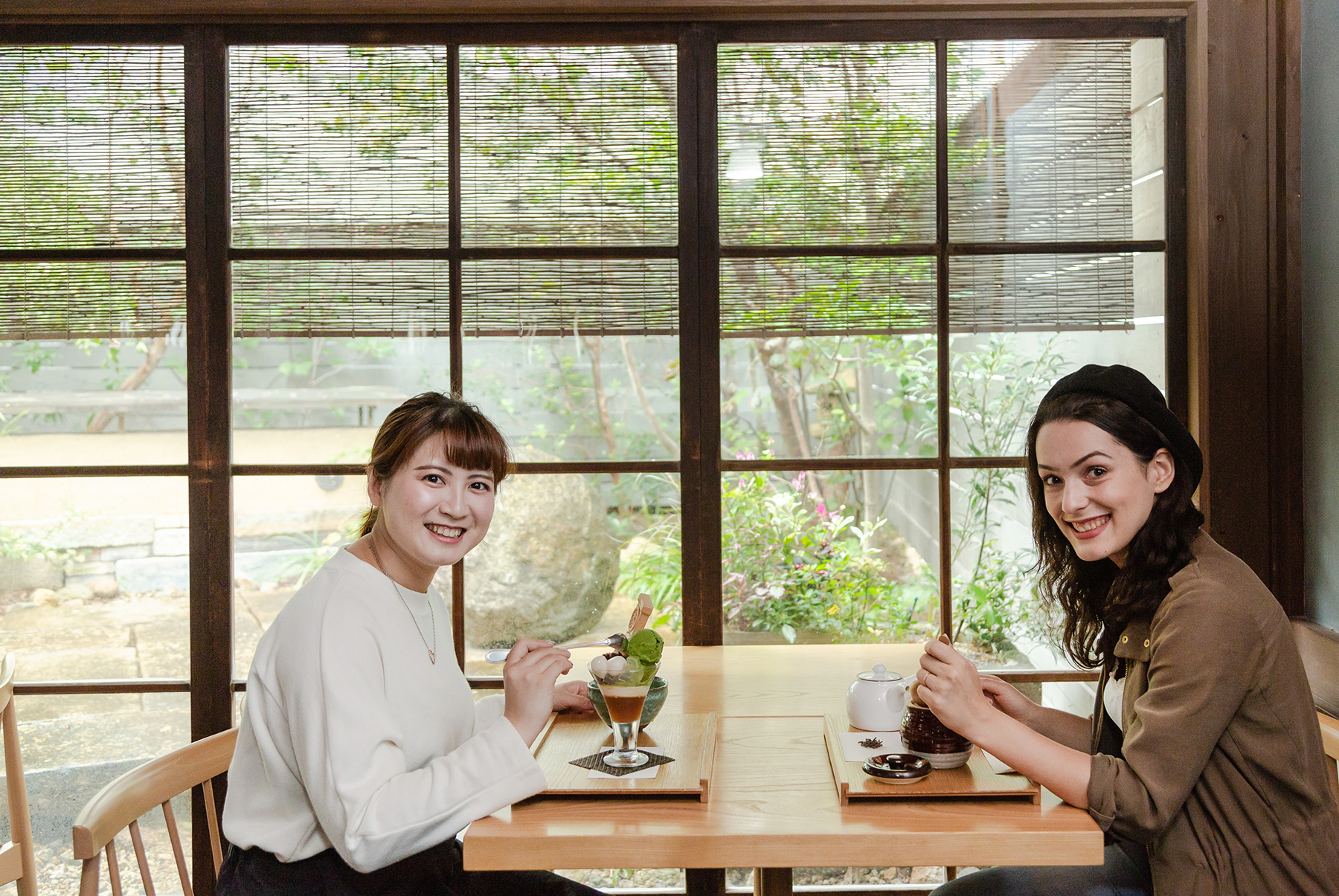
{{ // BLOCK END }}
After learning all about Sakai knives, take a break while enjoying some delicious Japanese tea. Sen no Rikyu, the tea master who did so much to promote the Tea Ceremony, was born in Sakai, and the city itself remains closely tied to this culture, meaning many places handling high quality tea can be found in the city. Tsuboichi Seicha is one such store, with a history of more than 160 years. The wide interior created by renovating a historic Machiya house contains both a tea room and shop.
Popular choices from the menu include the mellow and rich green tea, and the specialty green tea parfait loaded with intense green tea ice cream. The chestnut sweets limited to just fall and winter are delicious too, with warm and fluffy, sweet chestnuts filling your mouth.
{{ // BLOCK END }}
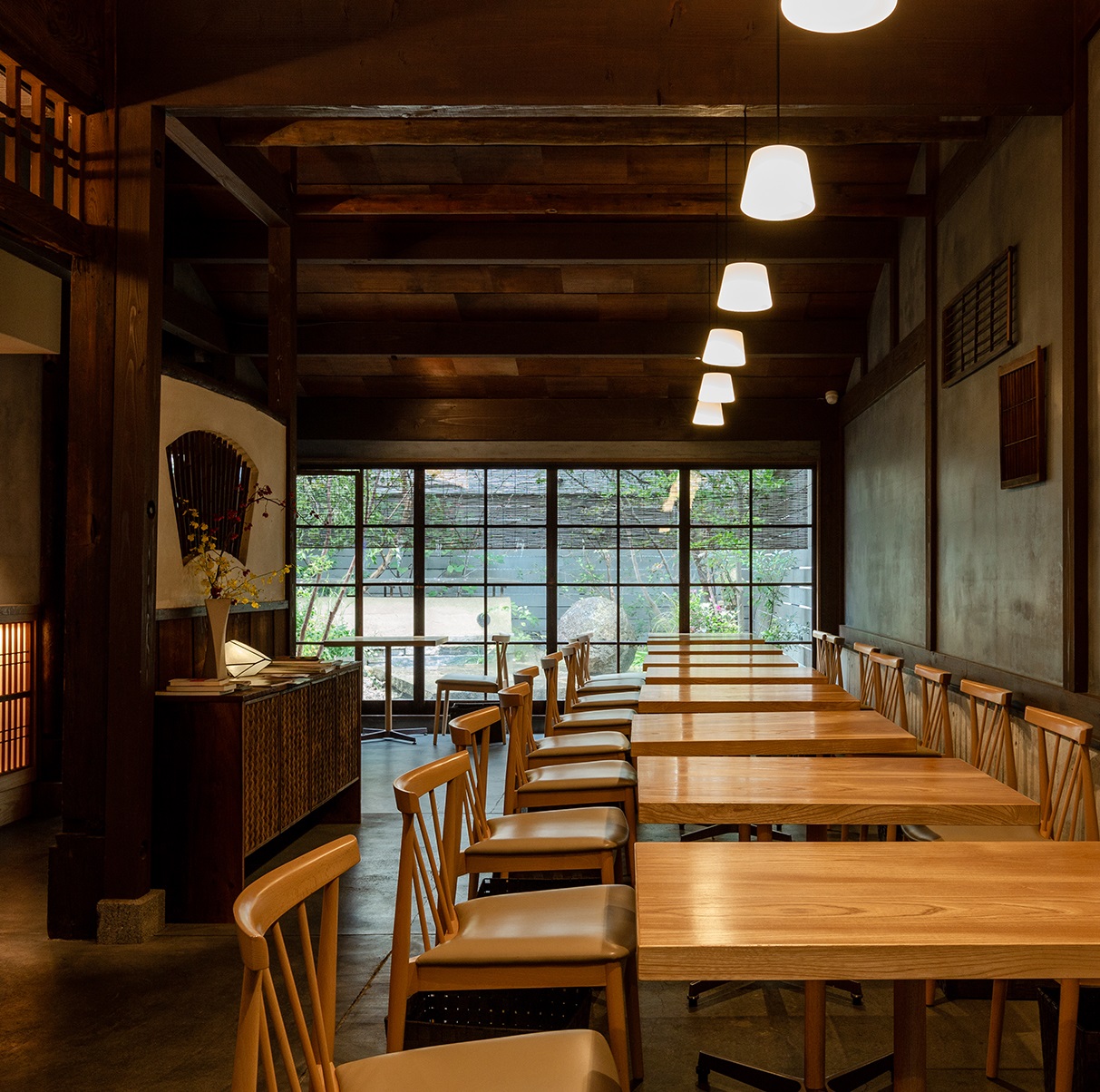
A renovated store making use of the rich character of a large, historic Machiya house. It is filled with the aroma of roasting tea.
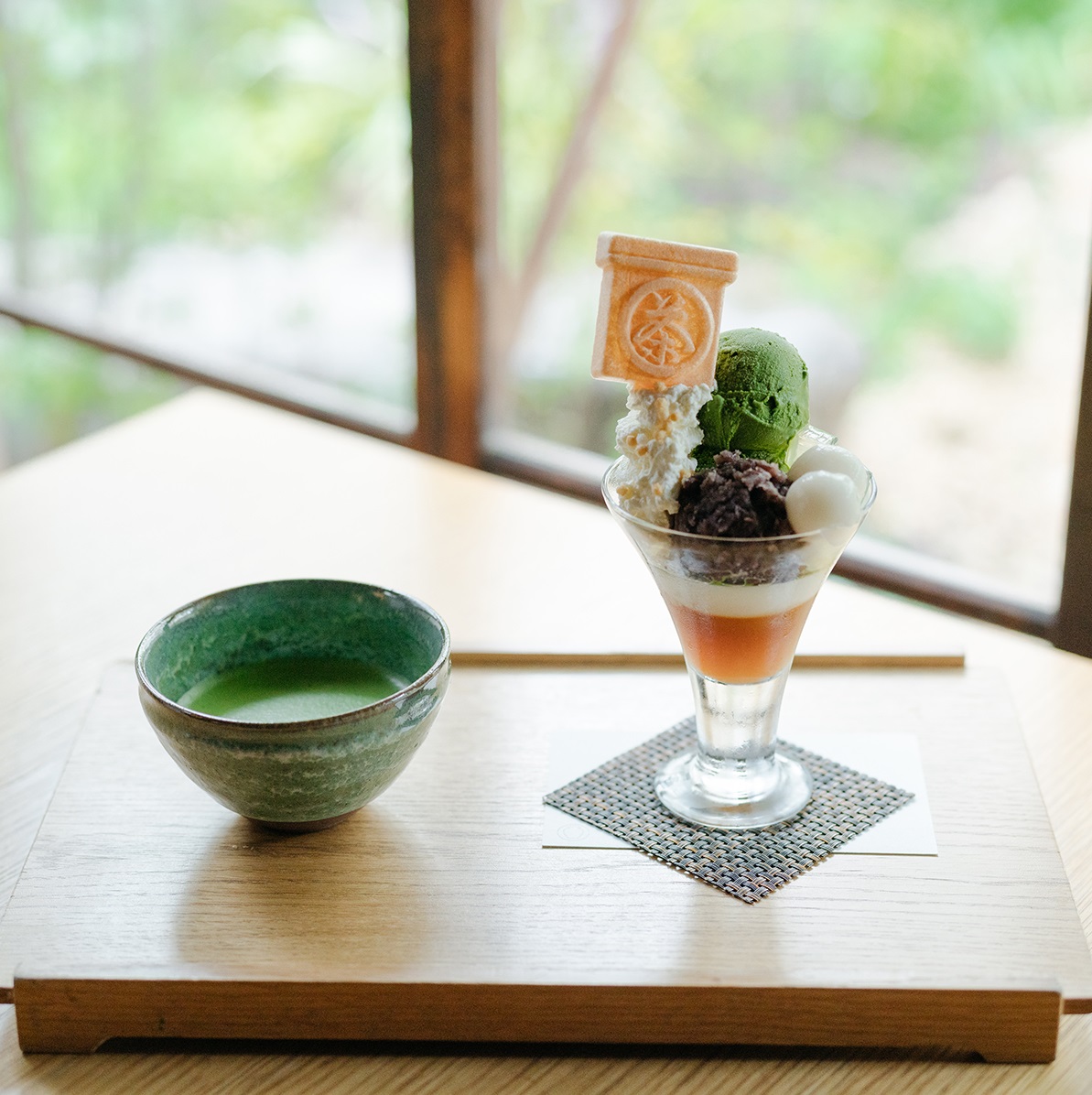
The specialty green tea parfait, perfectly combining green tea ice cream and roasted green tea jelly, is 864 yen, while the green tea "Sakai's past" is 594 yen.
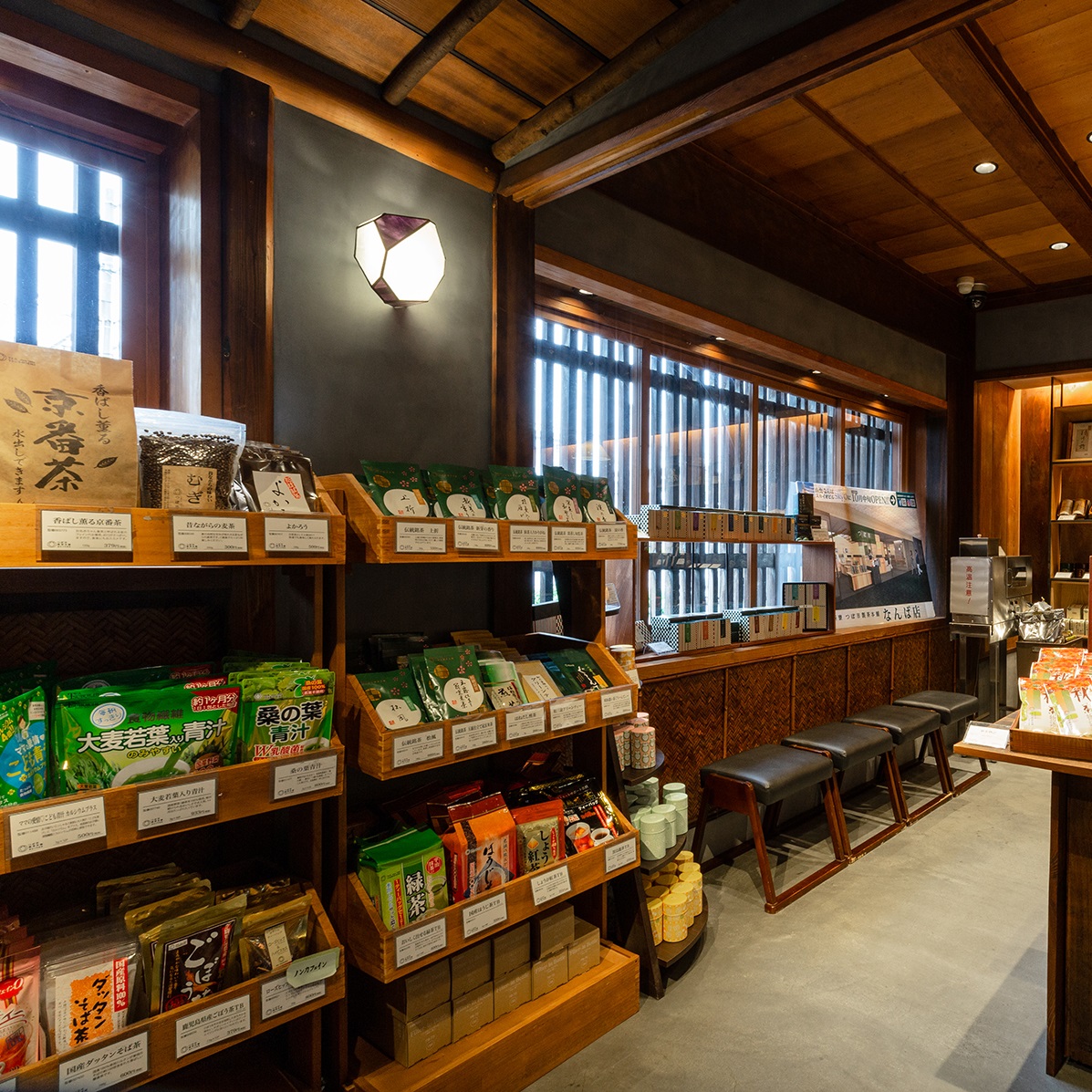
The shop is packed with carefully selected Japanese tea. You can also find a delicious roasted green tea latté in a convenient teabag.
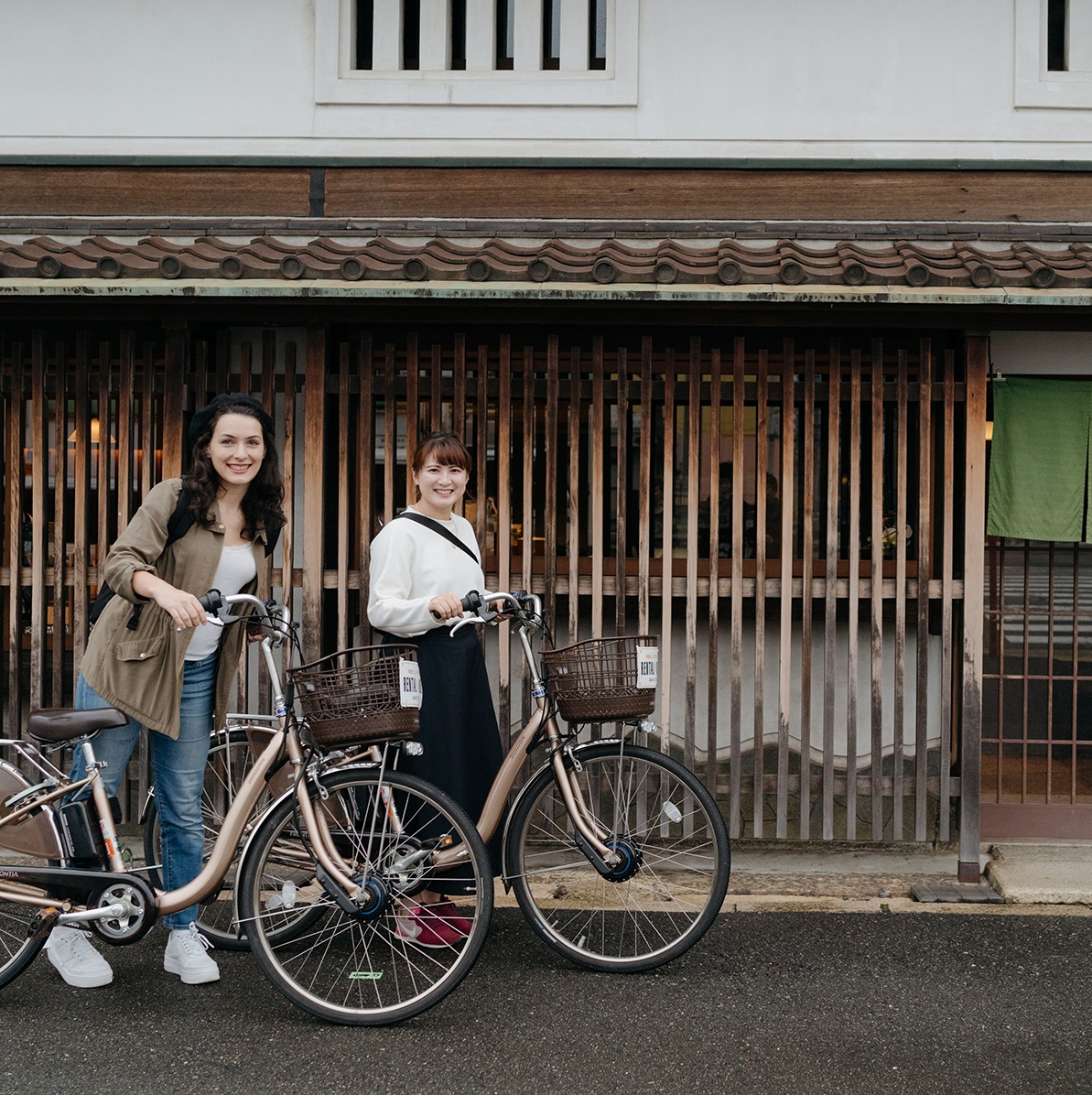
The exterior recalls the old-time streets of Sakai. Don't forget to take a commemorative photo here!
{{ // BLOCK END }}
Required Time: Approximately 0.5km, 3 minutes ->
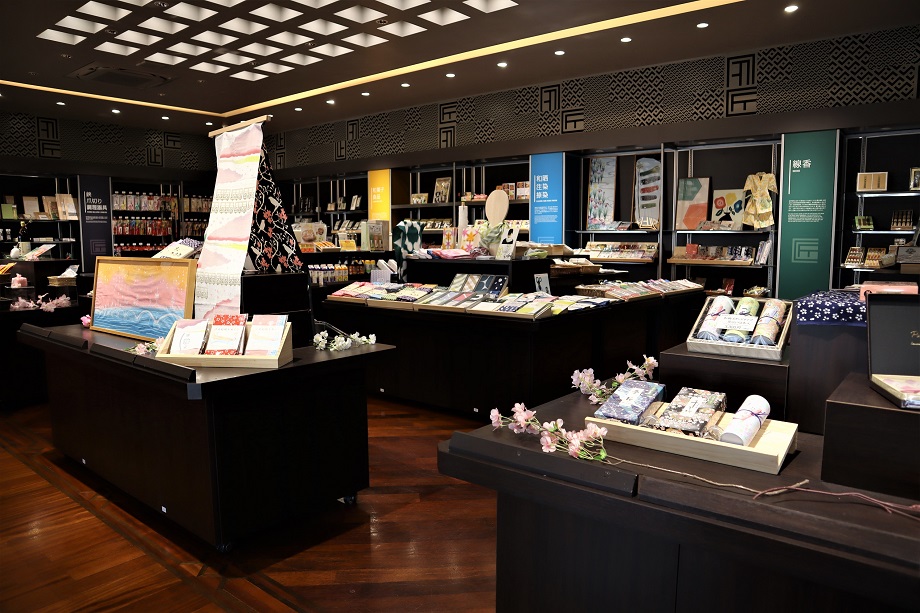
{{ // BLOCK END }}
The best possible end to a tour can only be choosing some souvenirs! The Sakai Traditional Crafts Museum is for exhibition, sales and experience of Sakai’s traditional industries. The first floor retail space named TAKUMI SHOP: Knives & Whetstones offers a varied range of knives for all sorts of uses, made from different materials with several types of handles. In the TAKUMI SHOP: Traditional Crafts & Sakai Specialties you can find not only staples such as chusen and wazarashi garments and incense, but also spices perfect for everyday use and expertly crafted items that also make wonderful gifts. In the second floor, there are Sakai Knife Museum named “CUT” and Sakai traditional industries’ exhibition space named TAKUMI EXHIBITION.
{{ // BLOCK END }}
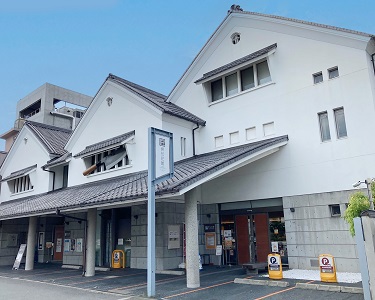
The exterior have a motif of a traditional Sakai townhouse. The eaves are so long, it is said that long ago you didn’t even need an umbrella.
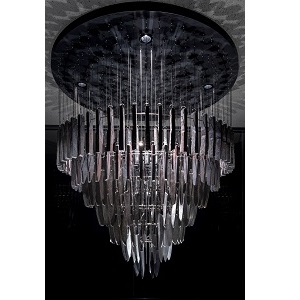
Awe-inspiring HIBANA chandelier made from materials used in the knife-making process.
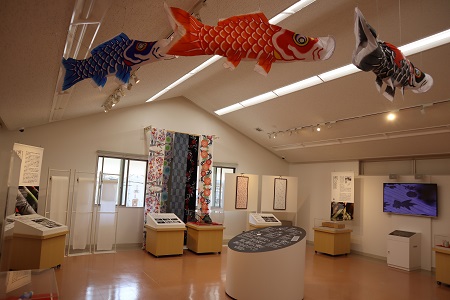
Skillfully used to show off garments made using chusen dyeing, nassen printing, and wazarashi bleaching, as well as Sakai carp streamers.
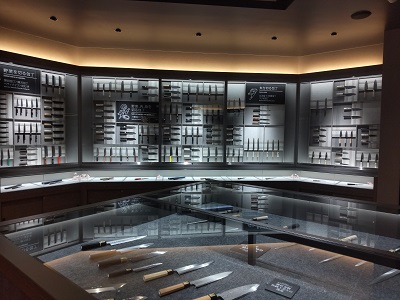
Easy to choose your favorite knife.
{{ // BLOCK END }}
Required Time: Approximately 1.1km, 7 minutes ->
Finally, you return to the starting point Sakai Station, where you will need to return your bicycle by 16:30.
Long ago, materials moved around Sakai on the moats (canals). These still remain all across the city, so why not follow some of them on your way back?
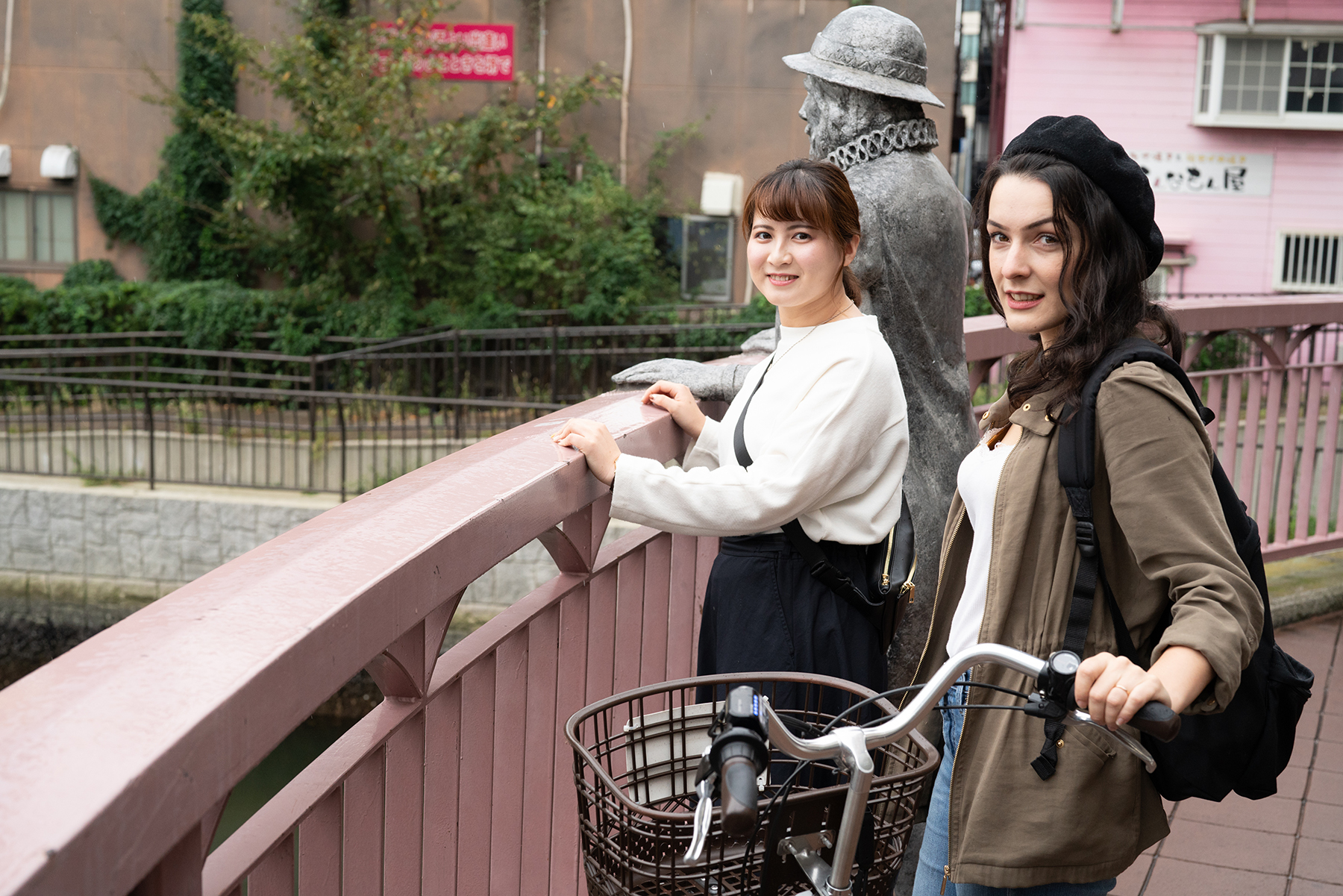
{{ // BLOCK END }}
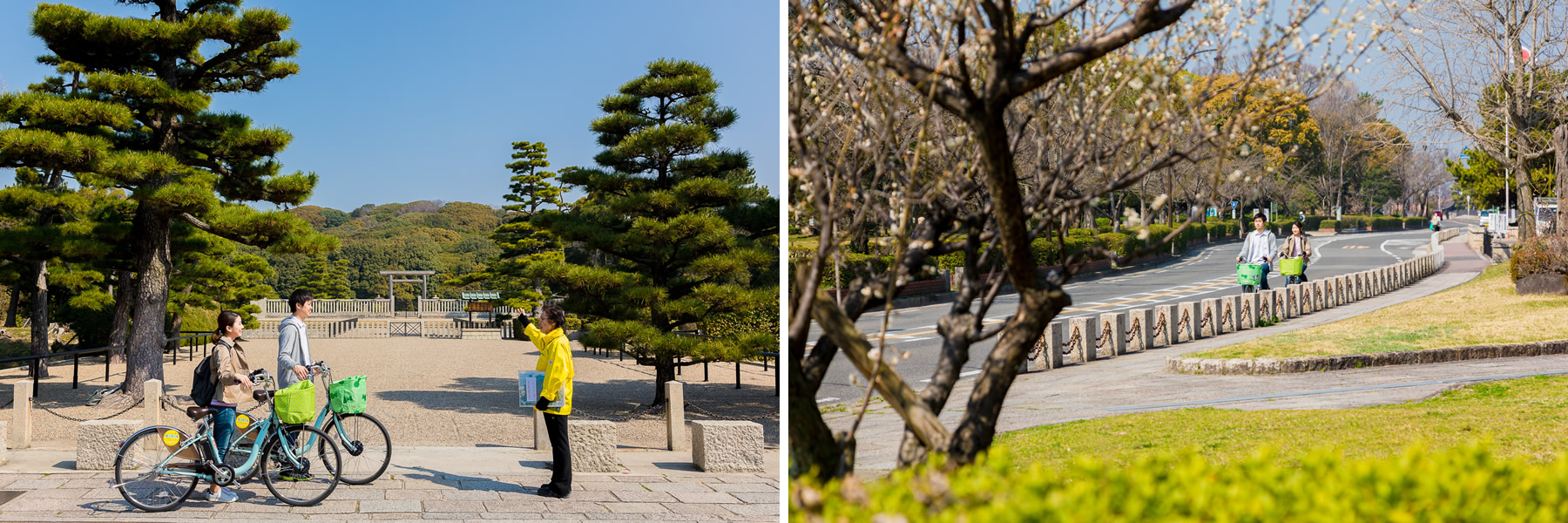
After taking a tour of the Sakai Old Town, it is also recommended to stretch your legs by visiting the Mozu Tumuli Cluster.
If you are using an electric assisted bicycle then you can reach the prayer place at the Nintoku-Tenno-Ryo Tumulus, the latest keyhole-shaped tumulus in Japan, in around 20 minutes from Sakai Station. There are a total of 44 tumuli in the cluster, created between the end of the 4th and 6th century, and a nimble bicycle is ideal for conveniently taking in the tumuli and their surroundings. Bicycles rented at Sakai Station can also be returned at the Daisen Park Tourist Information Center, located close to the Tumuli Cluster, so feel free to also make use of that option (opening hours 9:00 - 16:30).
{{ // BLOCK END }}
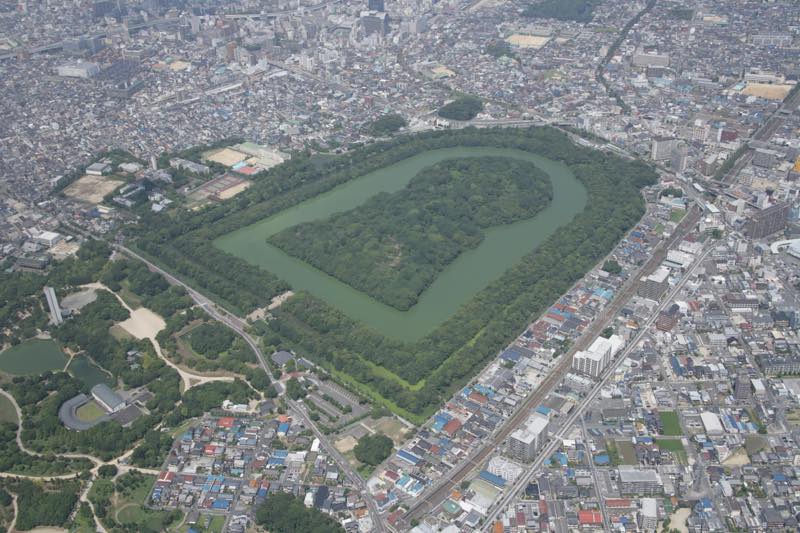
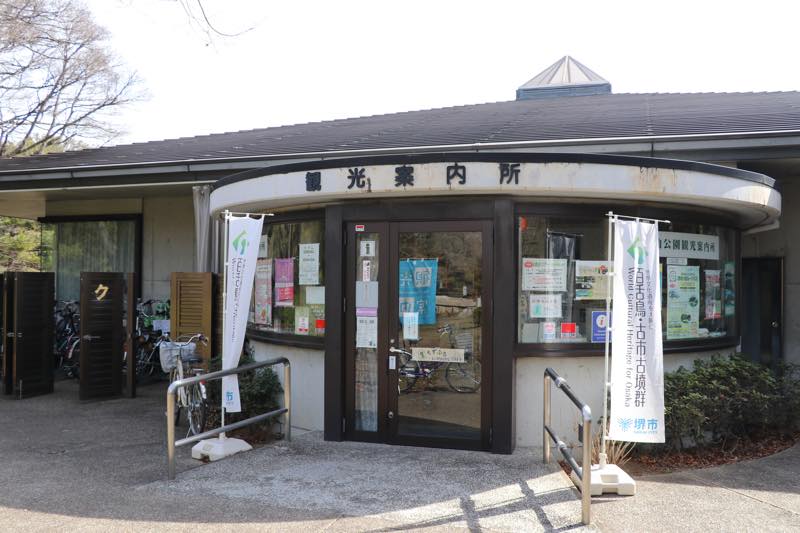
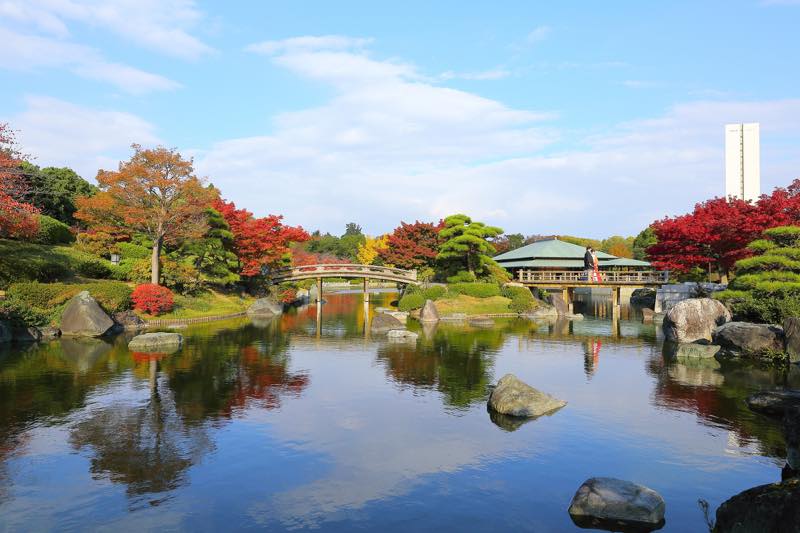
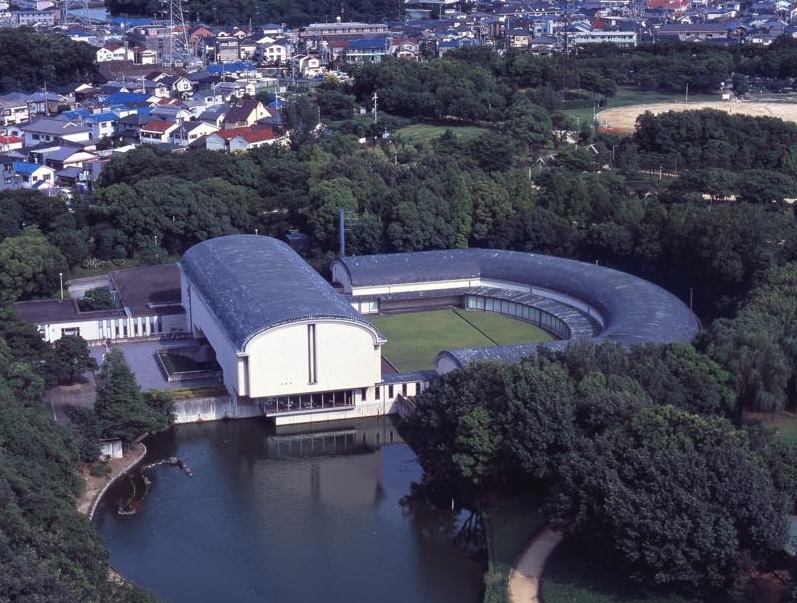
{{ // BLOCK END }}
{{ // BLOCK END }}
Model: CLAIRE (Anela Model), Chiaki Matsumoto (Sakai Tourism Concierge)
Photography: Yoshinori Yamazaki,Yuki Hamanaka,Keiko Yamaguchi
Report & Text: Noriko Yamaguchi
{{ // BLOCK END }
あなたは旧式のブラウザをご利用中です
このウェブサイトを快適に閲覧するにはブラウザをアップグレードしてください。